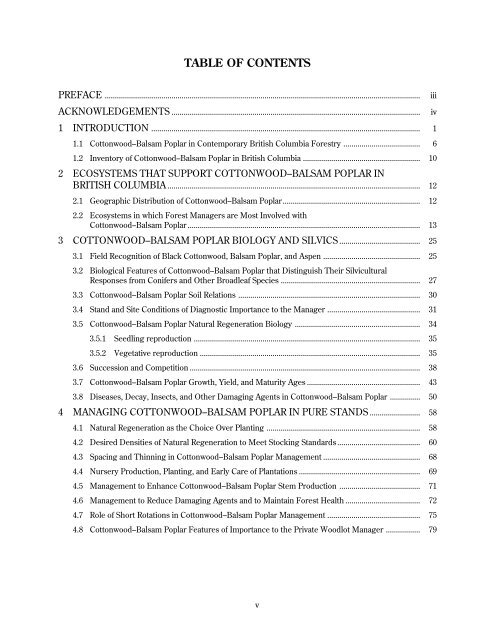FRDA Report: Black Cottonwood and Balsam Poplar Managers ...
FRDA Report: Black Cottonwood and Balsam Poplar Managers ...
FRDA Report: Black Cottonwood and Balsam Poplar Managers ...
You also want an ePaper? Increase the reach of your titles
YUMPU automatically turns print PDFs into web optimized ePapers that Google loves.
TABLE OF CONTENTS<br />
PREFACE ............................................................................................................................................................ iii<br />
ACKNOWLEDGEMENTS ........................................................................................................................... iv<br />
1 INTRODUCTION ..................................................................................................................................... 1<br />
1.1 <strong>Cottonwood</strong>–<strong>Balsam</strong> <strong>Poplar</strong> in Contemporary British Columbia Forestry ...................................... 6<br />
1.2 Inventory of <strong>Cottonwood</strong>–<strong>Balsam</strong> <strong>Poplar</strong> in British Columbia .......................................................... 10<br />
2 ECOSYSTEMS THAT SUPPORT COTTONWOOD–BALSAM POPLAR IN<br />
BRITISH␣ COLUMBIA ............................................................................................................................. 12<br />
2.1 Geographic Distribution of <strong>Cottonwood</strong>–<strong>Balsam</strong> <strong>Poplar</strong>.................................................................... 12<br />
2.2 Ecosystems in which Forest <strong>Managers</strong> are Most Involved with<br />
<strong>Cottonwood</strong>–<strong>Balsam</strong> <strong>Poplar</strong> ................................................................................................................... 13<br />
3 COTTONWOOD–BALSAM POPLAR BIOLOGY AND SILVICS ........................................ 25<br />
3.1 Field Recognition of <strong>Black</strong> <strong>Cottonwood</strong>, <strong>Balsam</strong> <strong>Poplar</strong>, <strong>and</strong> Aspen ................................................ 25<br />
3.2 Biological Features of <strong>Cottonwood</strong>–<strong>Balsam</strong> <strong>Poplar</strong> that Distinguish Their Silvicultural<br />
Responses␣ from Conifers <strong>and</strong> Other Broadleaf Species ..................................................................... 27<br />
3.3 <strong>Cottonwood</strong>–<strong>Balsam</strong> <strong>Poplar</strong> Soil Relations .......................................................................................... 30<br />
3.4 St<strong>and</strong> <strong>and</strong> Site Conditions of Diagnostic Importance to the Manager .............................................. 31<br />
3.5 <strong>Cottonwood</strong>–<strong>Balsam</strong> <strong>Poplar</strong> Natural Regeneration Biology .............................................................. 34<br />
3.5.1 Seedling reproduction ................................................................................................................ 35<br />
3.5.2 Vegetative reproduction ............................................................................................................. 35<br />
3.6 Succession <strong>and</strong> Competition .................................................................................................................. 38<br />
3.7 <strong>Cottonwood</strong>–<strong>Balsam</strong> <strong>Poplar</strong> Growth, Yield, <strong>and</strong> Maturity Ages ........................................................ 43<br />
3.8 Diseases, Decay, Insects, <strong>and</strong> Other Damaging Agents in <strong>Cottonwood</strong>–<strong>Balsam</strong> <strong>Poplar</strong> ............... 50<br />
4 MANAGING COTTONWOOD–BALSAM POPLAR IN PURE STANDS ......................... 58<br />
4.1 Natural Regeneration as the Choice Over Planting ............................................................................ 58<br />
4.2 Desired Densities of Natural Regeneration to Meet Stocking St<strong>and</strong>ards ......................................... 60<br />
4.3 Spacing <strong>and</strong> Thinning in <strong>Cottonwood</strong>–<strong>Balsam</strong> <strong>Poplar</strong> Management ................................................ 68<br />
4.4 Nursery Production, Planting, <strong>and</strong> Early Care of Plantations ............................................................ 69<br />
4.5 Management to Enhance <strong>Cottonwood</strong>–<strong>Balsam</strong> <strong>Poplar</strong> Stem Production ........................................ 71<br />
4.6 Management to Reduce Damaging Agents <strong>and</strong> to Maintain Forest Health ..................................... 72<br />
4.7 Role of Short Rotations in <strong>Cottonwood</strong>–<strong>Balsam</strong> <strong>Poplar</strong> Management .............................................. 75<br />
4.8 <strong>Cottonwood</strong>–<strong>Balsam</strong> <strong>Poplar</strong> Features of Importance to the Private Woodlot Manager ................. 79<br />
v

















